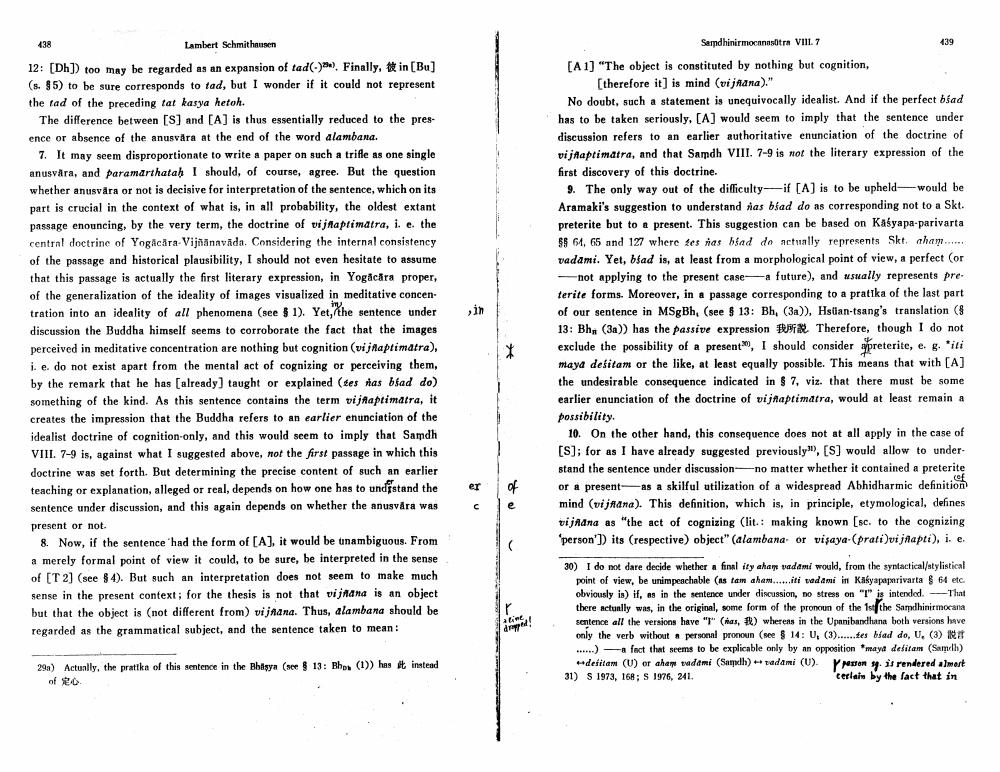Book Title: On Vinaptimatra Passage In Samadhinirmocanasutra VIII Author(s): L Schmithausen Publisher: L Schmithausen View full book textPage 4
________________ Sardhinirmocanestra VIL 7 Lambert Schmithausen 12: (Dh]) too may be regarded as an expansion of tad(.)). Finally, tin [Bu] (595) to be sure corresponds to tad, but I wonder if it could not represent the fad of the preceding tat kasya hetoh. The difference between [S] and [A] is thus essentially reduced to the presence or absence of the anusvåra at the end of the word alambana 7. It may seem disproportionate to write a paper on such a trifle as one single anusvara, and paramarthatah I should, of course, agree. But the question whether anusvara or not is decisive for interpretation of the sentence, which on its part is crucial in the context of what is, in all probability, the oldest extant passage enouncing, by the very term, the doctrine of pijnaprimatra. i. e. the central doctrine of Yogacara-Vijñānavāda. Considering the internal consistency of the passage and historical plausibility, I should not even hesitate to assume that this passage is actually the first literary expression, in Yogacara proper, of the generalization of the ideality of images visualized in meditative concen tration into an ideality of all phenomena (see $ 1). Yet, the sentence under discussion the Buddha himself seems to corroborate the fact that the images perceived in meditative concentration are nothing but cognition (vijnaprimatra), i. e, do not exist apart from the mental act of cognizing or perceiving them, by the remark that he has already taught or explained (des has bfad do) something of the kind. As this sentence contains the term vijnaprimaira, it creates the impression that the Buddha refers to an earlier enunciation of the idealist doctrine of cognition-only, and this would seem to imply that Samdh VIIL 7-9 is, against what I suggested above, not the first passage in which this doctrine was set forth. But determining the precise content of such an earlier teaching or explanation, alleged or real, depends on how one has to und stand the sentence under discussion, and this again depends on whether the anusvira was present or not. 8. Now, if the sentence had the form of [A], it would be unambiguous. From a merely formal point of view it could, to be sure, be interpreted in the sense of [T 2) (see $4). But such an interpretation does not seem to make much sense in the present context; for the thesis is not that vijnana is an object but that the object is not different from) vijnana. Thus, alambana should be regarded as the grammatical subject, and the sentence taken to mean: [A1] "The object is constituted by nothing but cognition, [therefore it] is mind (vijnana)." No doubt, such a statement is unequivocally idealist. And if the perfect blad has to be taken seriously, (A) would seem to imply that the sentence under discussion refers to an earlier authoritative enunciation of the doctrine of vijnaprimatra, and that Samdh VIII. 7-9 is not the literary expression of the first discovery of this doctrine. 9. The only way out of the difficulty--if (A) is to be upheld would be Aramaki's suggestion to understand ias bśad do as corresponding not to a Skt. preterite but to present. This suggestion can be based on Kasyapa.parivarta $$ 64, 65 and 127 where ses nas biad do actually represents Skt. aham....... vadami. Yet, blad is, at least from a morphological point of view, a perfect (or - not applying to the present case- a future), and usually represents preterite forms. Moreover, in a passage corresponding to a pratika of the last part of our sentence in MSgBh, (see $ 13: Bh, (3a)), Hsuan-tsang's translation ( 13: Bh. (3a)) has the passive expression of Therefore, though I do not exclude the possibility of a present, I should consider preterite, e. & 'iti maya delitam or the like, at least equally possible. This means that with [A] the undesirable consequence indicated in $7, viz. that there must be some earlier enunciation of the doctrine of vijAaptimatra, would at least remain possibility, 10. On the other hand, this consequence does not at all apply in the case of (S); for as I have already suggested previously", [S] would allow to under stand the sentence under discussion—no matter whether it contained a preterite or a presenta a skilful utilization of a widespread Abhidharmic definition mind (vijnana). This definition, which is, in principle, etymological, defines vijnana as "the act of cognizing (lit.: making known [sc. to the cognizing 'person'] its (respective) object" (alambana or visaya (prativi japti), i.e. er of 30) I do not dare decide whether a finality chay vadami would, from the syntactical/stylistical point of view, be unimpeachable (ns tam aham......iti sadami in Kasapaperivarta 64 etc. obviously in) if, as in the sentence under discussion, no stress on " T intended. --That there actually was, in the original, some form of the pronoun of the 1st the Samdhinirmocana sentence all the versions have "T" (has, .) whereas in the Upanibanduna both versions have only the verb without personal pronoun (see $ 14: U. (3)......tes had do, U. (3) R7 ......) fnct that seems to be explicable only by an opposition maya delitam (Samh) detitam (U) or aham adami (Sad) + vadami (U). Y son t rendered almost 31) S 1973, 168; S 1976, 241. cerlain by the fact that in 290) Actually, the pratika of this sentence in the Bhagya (nee 13: Mhes (1)) bus #insteadPage Navigation
1 2 3 4 5 6 7 8 9 10 11 12
